
I picked up these brass parts at a local hobby shop. They are .016 inches thick x 12 inches long. The large set is two inches wide; the small set is one inch. These pieces will make the metal part of the base that fits into the wooden base. Clear as mud, right?

I carefully cut two of the one-inch brass pieces into six inch lengths.

After cleaning them up with 150 grit sandpaper, I will add the tinning. (I don't know if I'm saying this right. All I'm going to do is cover the pieces with a thin coat of solder.)

First brass piece, partially tinned.

Here are all four brass pieces completely covered in solder and ready to apply to the lamp.

I am now about to solder the first two brass parts to the botton of the lamp. This section of brass will eventually make a sturdy base that will easily support the weight of the glass lamp.

The second pair of one-inch brass parts overlap the first. I will solder them all together. The solder lines that connect the brass parts to each other will not be noticed once the lamp is assembled. However, the solder lines where the brass and the lamp connect will be noticeable. Keep them nice and tidy. (But don't look to closely at mine!)

This section of brass pictured above (I call it the "slip") will eventually slide into a rabbet cut into the wooden base. It will provide stability for the heavy glass but it must be fitted precisely.
After cleaning them up with 150 grit sandpaper, I took two of the twelve-inch long and two-inch wide parts and bent them in my vise. I bent each piece so that it would have two five-inch long sides and one two-inch long side. It looked like an unfinished "U" when it was all said and done.
These two pieces are "clamped" together with paper clips and centered so that there is 1/2 of an inch showing all around. I soldered the two matching pieces together. Then I tinned the upper half of the "slip" and soldered it into place.

Next time I will start on the wooden base. I have some really nice figured Walnut that I salvaged from becoming firewood!



























